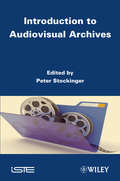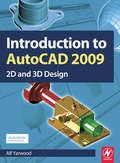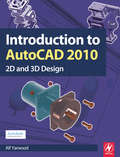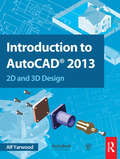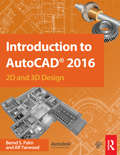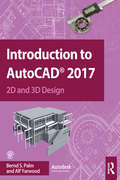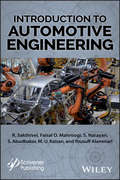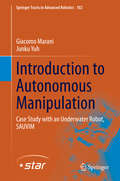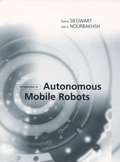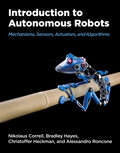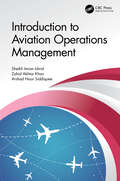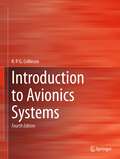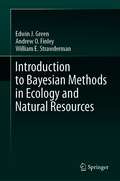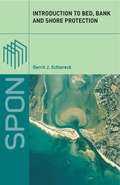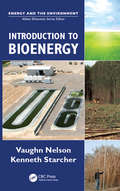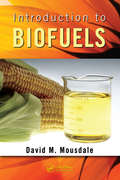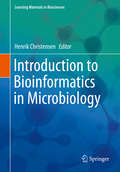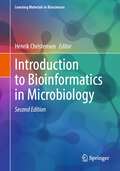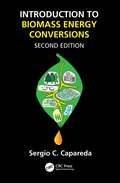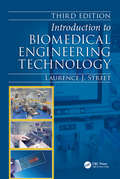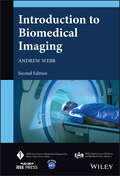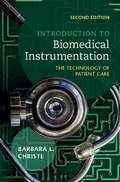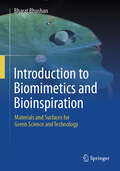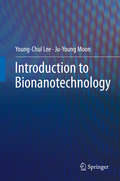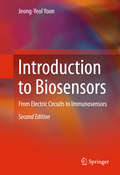- Table View
- List View
Introduction to Audiovisual Archives
by Peter StockingerToday, audiovisual archives and libraries have become very popular especially in the field of collecting, preserving and transmitting cultural heritage. However, the data from these archives or libraries – videos, images, sound tracks, etc. – constitute as such only potential cognitive resources for a given public (or "target community"). They have to undergo more or less significant qualitative transformations in order to become user- or community-relevant intellectual goods. These qualitative transformations are performed through a series of concrete operations such as: audiovisual text segmentation, content description and indexing, pragmatic profiling, translation, etc. These and other operations constitute what we call the semiotic turn in dealing with digital (audiovisual) texts, corpora of texts or even entire (audiovisual) archives and libraries. They demonstrate practically and theoretically the well-known "from data to meta-data" or "from (simple) information to (relevant) knowledge" problem – a problem that obviously directly influences the effective use, the social impact and relevancy and therefore also the future of digital knowledge archives.It constitutes, indeed, the heart of a diversity of important R&D programs and projects all over the world.
Introduction to AutoCAD 2009
by Alf YarwoodAlf Yarwood provides a practical, structured course of work matched to the latest release of AutoCAD. After introducing first principles and the creation of 2D technical drawings, he goes on to demonstrate the construction of 3D solid and surface model drawings and rendering. All the new features of the 2009 software release are taken into account and the increasing emphasis on 3D solid modelling in the software is reflected in the book. The 2D chapters are also suitable for those learning how to use AutoCAD LT 2009.Suitable for all new users of AutoCAD, this book is particularly applicable to vocational and introductory level undergraduate courses in engineering and construction. It is an ideal textbook for the City & Guilds Computer Aided Design and Engineering qualifications (4353 and 2303)and the relevant CAD units of BTEC National and BTEC Higher National Engineering and Construction schemes from Edexcel.A free companion website is available at http://books.elsevier.com/companions/9780750689830 and features: Worked solutions and AutoCAD drawing files of stages and results for the exercises in the bookFurther exercises and multiple-choice questions with answers.
Introduction to AutoCAD 2010
by Alf YarwoodAlf Yarwood provides a practical, structured course of work matched to the latest release of AutoCAD. After introducing first principles and the creation of 2D technical drawings, he goes on to demonstrate the construction of 3D solid drawings, surface model drawings and rendering. All the new features of the 2010 software release are taken into account and the increasing emphasis on 3D solid modelling in the software is reflected in the book. The 2D chapters are also suitable for those learning how to use AutoCAD LT 2010.Suitable for all new users of AutoCAD, this book is particularly applicable to vocational and introductory level undergraduate courses in engineering and construction. Further Education students in the UK will find this an ideal textbook to cater for the City & Guilds 4353 and 2303 qualifications and the relevant CAD units of BTEC National and BTEC Higher National Engineering and Construction schemes from Edexcel. Many Foundation Degrees also contain CAD modules for which this book can be of use.Readers will also be able to visit a free companion website at http://books.elsevier.com/companions/9781856178686, where they will find worked solutions and AutoCAD drawing files of stages and results for the exercises in the book, as well as further exercises and multiple-choice questions with answers.
Introduction to AutoCAD 2013: 2D and 3D Design
by Alf YarwoodMaster the complexities of the world's bestselling 2D and 3D software with Alf Yarwood's Introduction to AutoCAD 2013. Ideally suited to new users of AutoCAD, this book will be a useful resource for drawing modules in both vocational and introductory undergraduate courses in engineering and construction. Alf Yarwood has once again produced a comprehensive, step-by-step introduction to the latest release of AutoCAD. Covering all the basic principles and acting as an introduction to 2D drawing, it also contains extensive coverage of all 3D topics, including 3D solid modelling and rendering.A fold-out list of frequently used keyboard shortcuts will help you perform actions quickly while working through the book, and an appendix of ribbon references clearly describes all the software tools that are used throughout the book.
Introduction to AutoCAD 2016: 2D and 3D Design
by Alf Yarwood Bernd S. PalmMaster the complexities of the world's bestselling 2D and 3D software with Introduction to AutoCAD 2016. Ideally suited to new users of AutoCAD, this book will be a useful resource for drawing modules in both vocational and introductory undergraduate courses in engineering and construction. A comprehensive, step-by-step introduction to the latest release of AutoCAD. Covering all the basic principles and acting as an introduction to 2D drawing, it also contains extensive coverage of all 3D topics, including 3D solid modelling and rendering. Written by a member of the Autodesk Developer Network. Hundreds of colour pictures, screenshots and diagrams illustrate every stage of the design process. Worked examples and exercises provide plenty of practice material to build proficiency with the software. Further education students in the UK will find this an invaluable textbook for City & Guilds AutoCAD qualifications as well as the relevant Computer Aided Drawing units of BTEC National Engineering, Higher National Engineering and Construction courses from Edexcel. Students enrolled in Foundation Degree courses containing CAD modules will also find this a very useful reference and learning aid.
Introduction to AutoCAD 2017: 2D and 3D Design
by Alf Yarwood Bernd S. PalmMaster the complexities of the world's bestselling 2D and 3D software with Introduction to AutoCAD 2017. Ideally suited to new users of AutoCAD, this book will be a useful resource for drawing modules in both vocational and introductory undergraduate courses in engineering and construction. A comprehensive, step-by-step introduction to the latest release of AutoCAD. Covering all the basic principles and acting as an introduction to 2D drawing, it also contains extensive coverage of all 3D topics, including 3D solid modelling and rendering. Written by a member of the Autodesk Developer Network. Hundreds of colour pictures, screenshots and diagrams illustrate every stage of the design process. Worked examples and exercises provide plenty of practice material to build proficiency with the software. Further education students will find this an invaluable textbook for City & Guilds AutoCAD qualifications as well as the relevant Computer Aided Drawing units of BTEC National Engineering, Higher National Engineering and Construction courses from Edexcel. Students enrolled in Foundation Degree courses containing CAD modules will also find this a very useful reference and learning aid.
Introduction to Automotive Engineering
by R. Sakthivel Faisal O. Mahroogi S. Narayan S. Abudbaker M. U. Kaisan Youssef AlammariThe automotive industry is one of the largest and most important industries in the world. Cars, buses, and other engine-based vehicles abound in every country on the planet, and it is continually evolving, with electric cars, hybrids, self-driving vehicles, and so on. Technologies that were once thought to be decades away are now on our roads right now. Engineers, technicians, and managers are constantly needed in the industry, and, often, they come from other areas of engineering, such as electrical engineering, process engineering, or chemical engineering. Introductory books like this one are very useful for engineers who are new to the industry and need a tutorial. Also valuable as a textbook for students, this introductory volume not only covers the basics of automotive engineering, but also the latest trends, such as self-driving vehicles, hybrids, and electric cars. Not only useful as an introduction to the science or a textbook, it can also serve as a valuable reference for technicians and engineers alike. The volume also goes into other subjects, such as maintenance and performance. Data has always been used in every company irrespective of its domain to improve the operational efficiency and performance of engines. This work deals with details of various automotive systems with focus on designing various components of these system to suit the working conditions on roads. Whether a textbook for the student, an introduction to the industry for the newly hired engineer, or a reference for the technician or veteran engineer, this volume is the perfect introduction to the science of automotive engineering.
Introduction to Autonomous Manipulation
by Giacomo Marani Junku Yuh"Autonomous manipulation" is a challenge in robotic technologies. It refers to the capability of a mobile robot system with one or more manipulators that performs intervention tasks requiring physical contacts in unstructured environments and without continuous human supervision. Achieving autonomous manipulation capability is a quantum leap in robotic technologies as it is currently beyond the state of the art in robotics. This book addresses issues with the complexity of the problems encountered in autonomous manipulation including representation and modeling of robotic structures, kinematic and dynamic robotic control, kinematic and algorithmic singularity avoidance, dynamic task priority, workspace optimization and environment perception. Further development in autonomous manipulation should be able to provide robust improvements of the solutions for all of the above issues. The book provides an extensive tract on sensory-based autonomous manipulation for intervention tasks in unstructured environments. After presenting the theoretical foundations for kinematic and dynamic modelling as well as task-priority based kinematic control of multi-body systems, the work is focused on one of the most advanced underwater vehicle-manipulator system, SAUVIM (Semi-Autonomous Underwater Vehicle for Intervention Missions). Solutions to the problem of target identification and localization are proposed, a number of significant case studies are discussed and practical examples an d experimental/simulation results are presented. The book may inspire the robot research community to further investigate critical issues in autonomous manipulation and to develop robot systems that can profoundly impact our society for the better.
Introduction to Autonomous Mobile Robots
by Roland Siegwart Illah Reza NourbakhshMobile robots range from the teleoperated Sojourner on the Mars Pathfinder mission to cleaning robots in the Paris Metro. Introduction to Autonomous Mobile Robots offers students and other interested readers an overview of the technology of mobility--the mechanisms that allow a mobile robot to move through a real world environment to perform its tasks--including locomotion, sensing, localization, and motion planning. It discusses all facets of mobile robotics, including hardware design, wheel design, kinematics analysis, sensors and perception, localization, mapping, and robot control architectures. The design of any successful robot involves the integration of many different disciplines, among them kinematics, signal analysis, information theory, artificial intelligence, and probability theory. Reflecting this, the book presents the techniques and technology that enable mobility in a series of interacting modules. Each chapter covers a different aspect of mobility, as the book moves from low-level to high-level details. The first two chapters explore low-level locomotory ability, examining robots' wheels and legs and the principles of kinematics. This is followed by an in-depth view of perception, including descriptions of many "off-the-shelf" sensors and an analysis of the interpretation of sensed data. The final two chapters consider the higher-level challenges of localization and cognition, discussing successful localization strategies, autonomous mapping, and navigation competence. Bringing together all aspects of mobile robotics into one volume, Introduction to Autonomous Mobile Robots can serve as a textbook for coursework or a working tool for beginners in the field.
Introduction to Autonomous Robots: Mechanisms, Sensors, Actuators, and Algorithms
by Nikolaus Correll Bradley Hayes Christoffer Heckman Alessandro RonconeA comprehensive introduction to the field of autonomous robotics aimed at upper-level undergraduates and offering additional online resources.Textbooks that provide a broad algorithmic perspective on the mechanics and dynamics of robots almost unfailingly serve students at the graduate level. Introduction to Autonomous Robots offers a much-needed resource for teaching third- and fourth-year undergraduates the computational fundamentals behind the design and control of autonomous robots. The authors use a class-tested and accessible approach to present progressive, step-by-step development concepts, alongside a wide range of real-world examples and fundamental concepts in mechanisms, sensing and actuation, computation, and uncertainty. Throughout, the authors balance the impact of hardware (mechanism, sensor, actuator) and software (algorithms) in teaching robot autonomy. Features:Rigorous and tested in the classroomWritten for engineering and computer science undergraduates with a sophomore-level understanding of linear algebra, probability theory, trigonometry, and statisticsQR codes in the text guide readers to online lecture videos and animationsTopics include: basic concepts in robotic mechanisms like locomotion and grasping, plus the resulting forces; operation principles of sensors and actuators; basic algorithms for vision and feature detection; an introduction to artificial neural networks, including convolutional and recurrent variantsExtensive appendices focus on project-based curricula, pertinent areas of mathematics, backpropagation, writing a research paper, and other topicsA growing library of exercises in an open-source, platform-independent simulation (Webots)
Introduction to Aviation Operations Management
by Arshad Noor Siddiquee Zahid Akhtar Khan Sheikh Imran IshratAirline operations are large, complex, and expensive. Introduction to Aviation Operations Management attempts to systematically present the overall scenario of aviation industry and airline practices. Furthermore, concepts, strategies, and issues prevailing in the aviation industry are addressed through numerous operations management and optimization approaches. The book aims to provide readers with an insight into aviation industry practices with respect to airport management, resource allocation, airline scheduling, disruption management, and sustainability which are significant for day-to-day aviation operations. Features: Presents operations management perspectives in the aviation sector Discusses global scenarios of aviation industry and airline practices Concepts are explained through operations management and optimization approaches Discusses airport management, resource allocation, airline scheduling, and disruption management issues Includes standard practices and issues related to the aviation industry. This book is aimed at senior undergraduate students pursuing programs related to the aviation industry and operations management.
Introduction to Avionics Systems
by R.P.G. CollinsonNow in a revised fourth edition, this course-tested textbook explains the basic principles and underlying theory of the core avionic systems in modern civil and military aircraft. The new edition includes extensive revisions on the latest developments in helmet-mounted displays (HMDs), the use of helmet-mounted rate gyros for helmet tracking, HUD/HMD optical waveguide system technology, and the latest advances on replacing CRTs with solid state displays in HUDs. Updates on controls and fly-by-wire include a section on civil aircraft to cover the Airbus A350 and the advances in its flight control system over the Airbus A380. A new section on automatic flight control of vectored thrust aircraft covers the BAE Systems Harrier and the Lockheed Martin F-35B Lightning 2 Joint Strike Fighter. Detailed coverage is provided for F-35B flight control systems for vertical landing. Introduction to Avionic Systems, Fourth Edition is an ideal textbook for undergraduate and graduate courses in avionics and aeronautical engineering, as well as professional development and training courses for post-graduates entering the aerospace industry from a wide range of technical backgrounds and practicing engineers at all levels who require an understanding of avionic systems, aircraft navigation, flight control, and data transmission and systems.
Introduction to Bayesian Methods in Ecology and Natural Resources
by William E. Strawderman Edwin J. Green Andrew O. FinleyThis book presents modern Bayesian analysis in a format that is accessible to researchers in the fields of ecology, wildlife biology, and natural resource management. Bayesian analysis has undergone a remarkable transformation since the early 1990s. Widespread adoption of Markov chain Monte Carlo techniques has made the Bayesian paradigm the viable alternative to classical statistical procedures for scientific inference. The Bayesian approach has a number of desirable qualities, three chief ones being: i) the mathematical procedure is always the same, allowing the analyst to concentrate on the scientific aspects of the problem; ii) historical information is readily used, when appropriate; and iii) hierarchical models are readily accommodated.This monograph contains numerous worked examples and the requisite computer programs. The latter are easily modified to meet new situations. A primer on probability distributions is also included because these form the basis of Bayesian inference.Researchers and graduate students in Ecology and Natural Resource Management will find this book a valuable reference.
Introduction to Bed, Bank and Shore Protection
by Gerrit J. SchiereckIntroduction to Bed, Bank and Shore Protection provides students and professional engineers with the understanding and guidance to prevent the erosion of movable beds, banks and shorelines. In a world of rising sea levels and extreme weather conditions, these skills are increasingly important to the engineer as well as the wider community. The book starts with the underlying scientific principles behind hydraulics and soil mechanics and applies them to common practical situations for the protection of coastal and river beds, banks and shores. Based on the author's twenty years of experience, this blend of theory and practice provides the reader with useful knowledge that can be applied to a wide range of situations for the protection of the environment.
Introduction to Bioenergy
by Vaughn C. Nelson Kenneth L. StarcherExplore a Major Component of Renewable Energy <P><P>Introduction to Bioenergy takes a look at energy from biomass (thermal energy, power, liquid fuels, and biogas) and envisions a sustainable future fueled by renewable energy. From production to conversion to heat, power, and biofuel, this book breaks down the science of bioenergy and explains the major processes for its production, conversion, and use. <P><P>Covers Solar Energy, Bioenergy, and Biomass Resources <P><P>The book begins with an introduction to solar energy (the source of bioenergy) and then moves on to describe bioenergy, biomass, chemical conversion, and the renewable energy processes involved. The authors cover measurement energy parameters, analysis of data, and the prediction of energy production for different bio products. They also consider the institutional, environmental, and economic concerns surrounding bioenergy. <P><P>An all-inclusive resource covering a rapidly-advancing field, this book: <li>Explores the impact of climate change and global warming on the production of biomass <li>Describes the positive and negative effects of biomass production on ecosystems and biodiversity <li>Illustrates the use of biomass for the production of electricity <li>Considers the replacement of fossil fuels with biofuels, biofuel production, and emerging technologies <li>Addresses institutional and environmental issues relevant to bioenergy <li>Discusses factors impacting the economic feasibility of renewable energy systems <P><P>Introduction to Bioenergy defines major processes for the production, conversion, and use of bioenergy. A book suitable for coursework or self-study, this essential work serves students and practicing professionals in the renewable energy, environmental science, agriculture engineering, and biology fields.
Introduction to Biofuels (Mechanical and Aerospace Engineering Series)
by David M. MousdaleWhat role will biofuels play in the scientific portfolio that might bring energy independence and security, revitalize rural infrastructures, and wean us off of our addiction to oil? The shifting energy landscape of the 21st century, with its increased demand for renewable energy technology, poses a worrying challenge. Discussing the multidisciplin
Introduction to Bioinformatics in Microbiology (Learning Materials in Biosciences)
by Henrik ChristensenThis textbook introduces to the basic concepts of bioinformatics and enhances students’ skills in using software and tools relevant for investigations in microbiology. The most relevant methods to analyze data are shown and readers are introduced on how to draw valid conclusions based on the results obtained. Software and servers which are free to use on the internet are presented and more advanced stand-alone programs are suggested as a second option. Exercises and training quizzes are provided at the end of each chapter to facilitate learning. The book targets Ph. D. students and advanced undergraduates in microbiology, biotechnology, and (veterinary) medicine with little to basic knowledge in bioinformatics.
Introduction to Bioinformatics in Microbiology (Learning Materials in Biosciences)
by Henrik ChristensenThis updated and extended second edition of the textbook introduces the basic concepts of bioinformatics and enhances students' skills in the use of software and tools relevant to microbiology research. It discusses the most relevant methods for analysing data and teaches readers how to draw valid conclusions from the observations obtained. Free software and servers available on the Internet are presented in an updated version of 2023 and more advanced stand-alone software is proposed as a second option. In addition, new tools for microbial genome analysis and new flowcharts that complement the didactic elements have been added. Exercises and training questionnaires are included at the end of each chapter to facilitate learning. The book is aimed at Ph.D. students and advanced undergraduate students in microbiology, biotechnology, and (veterinary) medicine with little or basic knowledge of bioinformatics.
Introduction to Biomass Energy Conversions
by Sergio CaparedaIntroduction to Biomass Energy Conversions explores biomass energy conversions and characterization using practical examples and real-world scenarios. It begins with biomass resource estimation and extends to commercialization pathways for economical biomass conversion into high-value materials, chemicals, and fuels. With extended discussions of new sustainability issues in biofuels production, such as carbon capture and sequestration, the second edition has been updated with carbon footprint work life cycle analysis, the growing circular economy, and newer research directions of biomass resources, such as graphene production from biochar. This book covers thermo-chemical conversion processes, including torrefaction, pyrolysis, gasification and advanced gasification, biomass liquefaction, and combustion. This book is intended for senior undergraduate students taking Renewable Energy Conversions, Bio Energy, Biomass Energy, Introduction to Biofuels, and Sustainability Engineering courses. This book also features end-of-chapter problems, exercises, and case studies with a Solutions Manual available for instructors.
Introduction to Biomedical Engineering Technology
by Laurence J. StreetThis new edition provides major revisions to a text that is suitable for the introduction to biomedical engineering technology course offered in a number of technical institutes and colleges in Canada and the US. Each chapter has been thoroughly updated with new photos and illustrations which depict the most modern equipment available in medical technology. This third edition includes new problem sets and examples, detailed block diagrams and schematics and new chapters on device technologies and information technology.
Introduction to Biomedical Imaging: Physics, Engineering And Clinical Applications (IEEE Press Series on Biomedical Engineering)
by Andrew WebbIntroduction to BiomedicalImaging A state-of-the-art exploration of the foundations and latest developments in biomedical imaging technology In the newly revised second edition of Introduction to Biomedical Imaging, distinguished researcher Dr. Andrew Webb delivers a comprehensive description of the fundamentals and applications of the most important current medical imaging techniques: X-ray and computed tomography, nuclear medicine, ultrasound, magnetic resonance imaging, and various optical-based methods. Each chapter explains the physical principles, instrument design, data acquisition, image reconstruction, and clinical applications of its respective modality. This latest edition incorporates descriptions of recent developments in photon counting CT, total body PET, superresolution-based ultrasound, phased-array MRI technology, optical coherence tomography, and iterative and model-based image reconstruction techniques. The final chapter discusses the increasing role of artificial intelligence/deep learning in biomedical imaging. The text also includes a thorough introduction to general image characteristics, including discussions of signal-to-noise and contrast-to-noise. Perfect for graduate and senior undergraduate students of biomedical engineering, Introduction to Biomedical Imaging, 2nd Edition will also earn a place in the libraries of medical imaging professionals with an interest in medical imaging techniques.
Introduction to Biomedical Instrumentation
by Barbara ChristeThis fully updated second edition provides readers with all they need to understand the use of medical technology in patient care. Incorporating the most recent changes in healthcare, regulations, Standards, and technology, coverage is expanded to include new chapters on device testing, with a particular emphasis on safety inspections, and the interface of medical technology with the electronic medical record. A wide variety of medical instrumentation is discussed, focusing on device types and classifications, and including individual manufacturers as examples. It is designed for readers with a fundamental understanding of anatomy, physiology and medical terminology, as well as electronic concepts such as voltage, current, resistance, impedance, analog and digital signals, and sensors. Additional documents and solutions to end-of-chapter questions accompany the book online, providing biomedical engineering technicians with the resources and tools they need to become knowledgeable and effective members of the patient care team.
Introduction to Biomimetics and Bioinspiration: Materials and Surfaces for Green Science and Technology
by Bharat BhushanThis textbook provides a comprehensive overview of biomimetics and biologically inspired materials, capturing the essence of innovation that draws inspiration from nature. Featuring diverse examples of biomimetics, the book explores surfaces exhibiting characteristics such as roughness-induced super-phobicity/philicity, self-cleaning mechanisms, antifouling properties, low drag, reversible adhesion, high hardness, and mechanical toughness. It also covers phenomena like water harvesting, purification, insect locomotion, and piercing. The book emphasizes durable materials and surfaces with a strong focus on the Lotus Effect, superoleophobic/philic surfaces, anti-biofouling, water purification, oil-water separation, shark skin-inspired low-drag surfaces, gecko-inspired reversible adhesion, nanofabrication, water-harvesting, and mosquito-inspired painless piercing. This is the first textbook on biomimetics and bioinspired surfaces. It is tailored for undergraduate or graduate students of materials science, chemistry, physics, and biology, and serves as an excellent resource for a one-semester course in biomimetics/bioinspiration while also functioning as a valuable textbook for applied nanotechnology courses. Accessible to both novices and experts alike, as well as practitioners, solution seekers, and the intellectually curious, this book is poised to contribute to the advancement of biomimetics, fostering a deeper understanding of nature's design brilliance and its transformative potential in materials science.
Introduction to Bionanotechnology
by Young-Chul Lee Ju-Young MoonThis is a comprehensive overview of bionanotechnology to students in nanotechnology, biotechnology, bionanotechnology, related fields such as biology, chemistry, physics, and materials science and also everyone who is interested in this research area. It describes the definition of bionanomaterials, how they can be synthesized, characterized and applied in different fields. The current status and future of bionanotechnology, as well as its advantages and limitations, are comprehensively discussed throughout the book. This is an entry-level book which is easy for readers to understand its contents. In this book, we tried to identify the definition of bionanotechnology. Briefly, Bionanotechnology is the emerging research field that comes from the intersection of nanotechnology and biotechnology. Nanotechnology is referring to the design, development, and application of materials which at least one dimension at nanometer scale meanwhile biotechnology is developed based on knowledge about living systems and organisms to create or improve different products. The association of nanotechnology and biotechnology pave a way to develop a hybrid technology with unique features. Thus, this novel technology will be used to improve our living standard in different aspects from developing new medicine, food, and functional cosmetics, introducing new methods to analyze and treat cancer to protect environmental problems.
Introduction to Biosensors
by Jeong-Yeol YoonBiosensors: From Electric Circuits to Immunosensors discusses underlying circuitry of sensors for biomedical and biological engineers as well as biomedical sensing modalities for electrical engineers while providing an applications-based approach to the study of biosensors with over 13 extensive, hands-on labs. The material is presented using a building-block approach, beginning with the fundamentals of sensor design and temperature sensors and ending with more complicated biosensors.
